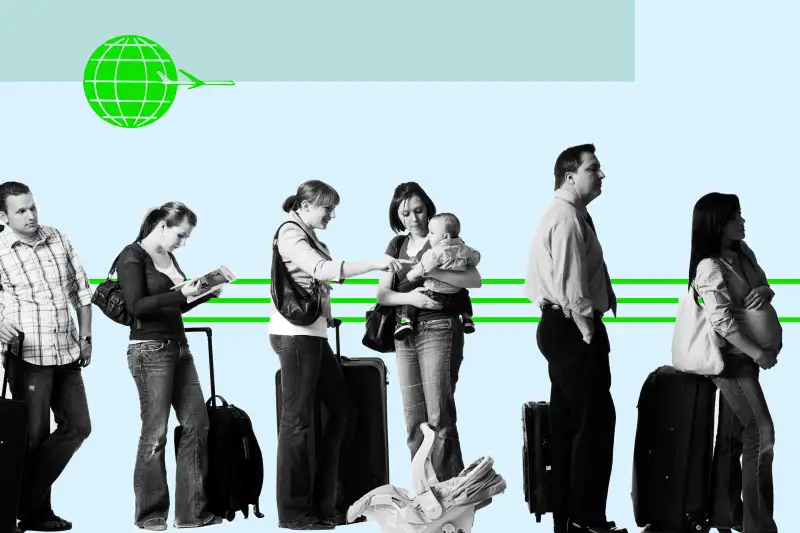TSA PreCheck Vs. Clear Showdown: Here's the Expedited Airport Experience I Found With the Best Value

I strongly believe that there is no better start to a trip than a security line that moves like a well-oiled machine.
Part of this fixation has to do with my inability to arrive at an airport earlier than I find necessary. I’m the type of traveler who claims to have a well-crafted system that gets me to my gate just in time to board, so I don't spend idle minutes buying food at the airport. And yeah — when everyone moves at the pace I account for, it works like a dream.
But every now and then, security throws me a curveball. My heart rate goes up, my shoes are off well before I reach the conveyor belt, and my patience dwindles for everyone and everything. I'm aware of my role in it all, and yet the tolerance involved in creeping through a winding security line, the speed of which depends on the know-how of hundreds of civilians...it tests me.
So you better believe I watched carefully as the world started rolling out services designed to expedite airport security — the least predictable part of my journey. I was hesitant to spend the money, but recently I tried the two most popular domestic options, Clear and TSA Precheck, and took the opportunity to compare accessibility, perks, restrictions, and price points along the way.
What Is Clear and How Good Is It?
We had arrived at Hartsfield-Jackson Airport with just enough time before take off, when my very cautious travel companion requested I sign up for the free month-long trial period Clear was temporarily offering. He had recently done so himself, and the kiosk to register stood right there between us and the security line that was making him feel all kinds of feelings.
The kiosks, which Clear started installing all over the country in 2010, are available at terminals in 31 airports across the U.S. Each one is manned by an attendant eagerly waiting to help you register or, if you're already a member, escort you right up to the podium: Using only your fingerprint or eye, the machine accesses your identification details — and eventually your boarding pass — so the attendant can vouch for you, effectively removing the identity verification part of your security experience (AKA the line).
After the free trial period, I would be charged $179 a year — a hefty price that would only be waived if I was a Delta SkyMiles member. I was not a member, but they were speaking my language about that line, and I was eager to see if this was a luxury I’d be willing to pay for. Fortunately for my friend, the onboarding process was incredibly fast. It took five minutes to answer a few questions and scan my fingers and eyes, and before I knew it, we were at our gate with time to spare, my travel buddy breathing easy again.
From then on, all I had to do was go to a kiosk at any Clear-friendly terminal to scan a fingertip and my boarding pass and an attendant would lead me right up to the podium where a TSA agent would glance down at my boarding pass and let me through. Then I would go through security the normal way: shoes off, liquids out ...you know the drill.
By the time my month long trial ended, I had only had a taste of that front-of-the-line freedom, so I snoozed my reminder to cancel my membership and paid the annual fee. Given the year full of weddings that was ahead of me, I felt like I was paying for my time. That is, until I hit the inevitable. When I went home for the holidays, there were so many people using Clear that the TSA agents were faced with a multi-line bottleneck situation. I felt like I paid $179 to stand there and wonder where my perks were.
It was incredibly convenient when it worked. But between the occasional backed-up line and having to fervently ask “But do you have Clear?!” at every new terminal, I wasn't prepared to pay that $179 again.
My TSA PreCheck Experience
I would have gone back to the traditional life of line-standing, but my new Chase Sapphire Reserve Card gave me a relevant perk: waiving the $85 fee for a five-year TSA PreCheck membership.
So once my Clear membership expired, I got started on the TSA PreCheck onboarding process, which turned out to be much longer and more multifold than Clear’s.
First, I applied online and scheduled an in-person interview. I waited three weeks, because the only appointments I could get within a week were at airports and honestly — who wants to do both ends of a New York travel day in one morning? The actual interview was surprisingly painless. I was out in 31 minutes, but I still had to wait to be approved so I could get my Known Traveler Number (KTN), which is the identification number that allows me to use my new TSA PreCheck status. They said it would take a couple of weeks, but it was only a matter of days before it was in my inbox. The whole process took just shy of 25 days.
Having that KTN means accessing the PreCheck line at over two hundred airports. It’s a beautiful system that lets you leave your shoes, belt, laptops, light jackets, tablets, and liquids as and where they are. If you get to a PreCheck line outside of operating hours (yes, they can be closed), you have to wait in the normal line, but get the expedited experience once you get to the front.
I quickly learned the downside, though.
To use your KTN, you have to manually enter it with your reservation. The goal is to plug it in when you’re booking online, via the airline website, but all airlines play differently. If you miss the opportunity or aren’t given the option online, airlines can differ about what to do next. You might be able to call the airline and do it over the phone. Or you might have to do it at a kiosk once you get to the airport.
By the time I got my KTN, I had already booked a handful of flights for the year. Trying to go back to put my KTN into each flight was a headache, especially since I booked through third-party sites (Kayak.com, Cheapoair, etc).
But somehow even with the added step of adding it on at the airport, it was a timesaver.
I still hadn’t quite figured out how it all worked the first time I went to the airport after getting my KTN, but Newark Liberty International Airport’s normal security line was zigging and zagging, moving in all kinds of mysterious ways. So I took my chances. I jumped out of line, ran back to a kiosk, found someone to help me, pulled up my flight, found and entered my KTN, ran back, and walked right through security.
When I looked back, my spot in the original line had moved a single zag.
Here’s My Take — For Now
As the more seasoned and brand-loyal PreCheck users know, you can add your KTN to a PreCheck-friendly frequent flyer account and not have to worry about putting it in every time you book a flight. But the only thing I frequent is a good deal-finding website, which means I'm not usually booking through an account with my KTN baked in. And that creates a whole extra step for me — a step that differs by airline (log into the airline's website, call the airline, or go to a kiosk or check-in desk at the airport). And while I haven’t experienced the long lines myself, I’ve heard that the TSA PreCheck line can get pretty lengthy.
With Clear, there are just so many benefits and not that many downsides. The onboarding process is seamless, the experience requires nothing of you except your fingertips or eye, and it’s exactly the same no matter what domestic airline you’re flying or what you booked it through — you don’t have to think about it until you get to the airport. Plus, it replaces a step to make it faster, rather than adding one altogether.
And one day, I will go back to Clear. I’ll be a Delta flyer and use my SkyMiles account to get a discounted price that will eventually be free. My future kids can use my membership until they're adults (Clear lets anyone under 18 accompany a member for free, while TSA PreCheck's maximum is 13) and hopefully by then it’ll be in more locations.
But forced to pick one today, I’m choosing to stick with PreCheck.
There’s something so liberating about being in a line where no one is fumbling with their belongings. But more than that it's about the math: It can be used at six times as many airports as Clear, and at a one-time $85 fee vs Clear’s annual $179 fee, it’s worth the price. Especially since that $85 fee can be waived with more ease than it takes to work your way up a membership program.
Of course, it is possible to use both: Get past the identity verification line using Clear, and then be escorted to a PreCheck line, where you get the expedited treatment. And if you’re willing to pay the fees, it’s the ultimate airport experience: Early arrivers can spend even more time and money at restaurants and bars, and last minute travelers can go into their carefully crafted agenda, knowing it won’t be derailed.
